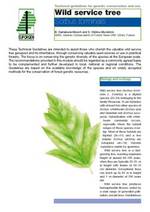Sorbus torminalis - Technical guidelines for genetic conservation and use for wild service tree
This publication has been translated into the following languages:
Slovenian Italian
In situ measures
Dynamic conservation maintains the diversity of evolving populations thanks to the combined effects of environmental pressure and sexual reproduction. In situ conservation is applied through a network of conservation units (natural stands).
For species with extinction-recolonization dynamics, it is not possible to define units of conservation. Indeed, the extinction-colonization events and high levels of seed flow could not be maintained in conservation units. Here, the issue is not to limit the large geneflow but rather to conserve it. It is also necessary to maintain the entire ecosystem dynamic because wild service tree dynamics are closely related to forest succession. Therefore, wild service tree conservation should not be practised at the local level (several hectares) but at the landscape level or even at the regional scale. For now, it is not possible to indicate a critical population size below which the populations would be threatened.
Conservation efforts need first to be focused on common forestry practices. For long-term sustainability of wild service tree genetic resources, forest management must be oriented in favour of each single tree. First, competition from neighbouring trees must be controlled and wild service trees need to be released at each logging intervention. Second, the forester must be aware that the seed trees of the neighbouring compartments will also contribute to regeneration. Most importantly, regeneration of wild service tree must be established before that of social broadleaves. In this way, the young wild service tree seedlings are given a competitive advantage against oaks or beeches. It is also important to ensure a regular distribution of wild service tree even with small clusters or single individuals. The local disappearance of some trees is not harmful to the population because seed flows allow colonization at long distances. But the forester must ensure the presence of a favourable site for new establishments. On the regional scale, an effort must be also made to favour the presence of wild service tree. The regional dynamics of geneflow are very important to conserve the local dynamic geneflow.
Ex situ measures
When it is not possible to apply in situ conservation, or measures for seed supply, ex situ conservation must be considered. To establish artificial conservation populations, the seeds must be collected from many trees with a distance of more than 200 m between them, to enlarge the genetic basis and to avoid relatedness. Planting conditions (site, planting distances, care and tending over the first years) must be carefully controlled. The core collections could be created regionally so that the seed could be used to reinforce some small populations. If the core collection is not isolated from other wild service trees (>10 km), geneflow can not be excluded. The strategy could be combined with ecological engineering techniques used in environmental restoration projects.
Authors: Brigitte Demesure-Musch; Sylvie Oddou-Muratorio
Journal/Series: Technical Guidelines for Genetic Conservation and Use
Publication Year: 2003
Publication Format: Folder; PDF
ISBN: 92-9043-665-4
ISBN 13: 978-92-9043-665-2
Language: EN
Pages: 6 p.

